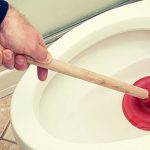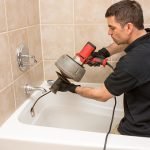Backwater valves prevent outbound water from re-entering a structure from which it was ejected, called “back-flowing.” They are a device which stops sewer backflow. Usually this is caused by excess water outside, as caused by a flood, or a blockage of the pipes from the outside, potentially caused by sewage or dirt. It may also be caused when there is excess rainwater and falling precipitation, and the city’s sewer lines are unable to handle so much fluid. Back-flowing mostly occurs in basements, but it also may occur on the first floor if the house is situated in a low area. Backwater valves are not to be confused with backflow preventers, which are devices that prevent home potable water sources from becoming contaminated by foul water, such as sewage.
Backwater Functionality
Standard backwater valves feature a normally open gate design which makes the flow of water easy when pipes are not overburdened. When water is overflowing, however, the gate will float to a closed position, preventing water from entering the house from the outside. However, air will still be allowed to flow through the valve. When the backwater valve is closed, the residents should be sure not to use any of the plumbing systems, because the fluid will be unable to exit the pipes and with extensive uses, the house’s own waste water may flood into the basement or first floor level. These plumbing systems include sinks, toilets, laundry, etc.
Backwater Valve Location
The backwater valve is installed in the sanitary or sewer line to prevent basements from becoming flooded. They should be always installed by a professional plumber. Backwater valves are required to be installed in most homes that reside in flood-prone areas. Whether a home requires a backwater valve is also dependent upon the location of the first upstream manhole, because in the situation that there is excess water, it can be drained from the upstream manhole cover rather than flowing into a nearby home or preventing that home’s pipes from functioning properly. However, some building codes require all homes install a backwater valve, for safety purposes in addition for the circumstance of natural disaster. When in doubt, especially when a second floor living space is installed, a backwater valve should be installed.
Financing of Backwater Valve Installation
Some cities may offer subsidies for homeowners to install backwater valves, to ensure the safety of their residents. For example, the City of Toronto approved a Basement Flooding Protection Subsidy Program, which granted a financial subsidy of up to $3,400 to single-family residential homeowners for the installation of flood-preventing devices such as backwater valves. However in especially dry states, such as California, these regulations may not be in place. In any situation, a backwater valve is a beneficial idea to prevent any potential flooding in basements and first floor levels. Especially in the scenario that a house resides in a wet area, a backwater valve is heavily recommended and some may find funding from local organizations or government.
Works Cited: N/a. “Determining If a Waste Backwater Valve Is Needed.” Determining If a Waste Backwater Valve Is Needed. Backwater Valves, n.d. Web. 25 Oct. 2016.






